|
Issue
#1 SB - 13 | 09 - 15
September | Lyon, France.
|
|
Tuesday
12 September 2000
|
| Monday
11 September 2000 |
|
|
|
 Title:
Forum on Additionality and Project-Based Mechanisms Title:
Forum on Additionality and Project-Based Mechanisms
Sponsor: CC:Forum
Contact: Kai-Uwe Barani Schmidt <kschmidt@unfccc.int>
Internet: http://www.unfccc.int
Kai-Uwe
Barani Schmidt, FCCC Secretariat, introduced the two presentations:
"Additionality under mechanisms" and "Alternative approaches to
project additionality". Robert Kleiburg, Shell International
Limited, presented the company's work on pilot CDM projects. He
outlined a case study on rural electrification in the Philippines
and discussed the various factors that influence additionality,
including emissions, finance, investment and technology. He emphasized
the challenges of investment additionality and suggested ways forward
through benchmarking projects. Jane Ellis, OECD, raised the
issue of administrative and time constraints for monitoring project
additionality. Hesphina Rukato, Minerals and Energy Policy
Center, South Africa, said that the Philippine case was a useful
example for South Africa, where rural electrification is a national
priority.
Paul Stolpman (pictured above right), US Environmental Protection
Agency, outlined a US proposal for measuring additionality. He recommended
that the approach should aim to: contain an objective determination
of additionality and baseline units (BAU); encourage investments
in cleaner technology; and limit transaction costs. He suggested
that the key to a successful CDM would be to develop baselines that
account for national circumstances, promote the best performing
technologies, and adjust CERs to circumstances. Patricia Iturregui,
National Commission of the Environment (CONAMA), Peru, illustrated
an argument that the baseline should equal Annex I average project
emissions.
|
|
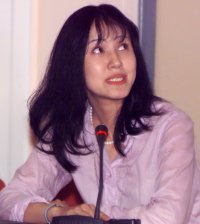 Title:
Issues and opportunities for investing in the Clean Development
Mechanism Title:
Issues and opportunities for investing in the Clean Development
Mechanism
Sponsor: Institute for Global Environmental Strategies (IGES)
Contact: Aki Maruyama <maruyama@iges.or.jp>
Internet: http://www.iges.or.jp
Taka
Hiraishi, Co-Chair of the Intergovernmental Panel on Climate
Change, introduced three speakers from IGES and invited participants
to focus on scientific and economic issues. Aki Maruyama
(right) examined the "Barriers to CDM investment and possible public
support measures." She concluded that the CDM could help direct
foreign direct investment towards climate friendly investment if
public funding could be used to address the risks and costs associated
with the CDM. She proposed that risk management could be addressed
using public funding to focus on those areas the CDM cannot address
and by supporting measures to facilitate private sector investment
in the CDM. Tae Yong Jung presented a paper compiled with Shinji
Kaneko, IGES, on the "Economic effect of international transactions",
providing initial results from a case study on Japan's bilateral
transactions with China.
Naoki
Matsuo presented a "Proposal for a prompt start of Annex I emission
reduction projects." He outlined a possible compromise decision
at COP-6, which would create coherence between the CDM and JI by
applying similar levels of rigor, using a common institutional home
and providing for a preliminary pilot phase, with crediting, for
post-2008 Joint Implementation. Matsuo also presented a paper in
which he identified the difficulties of identifying profitable project
additionality and argued for baseline standardization to establish
consistency, credibility and reduce transaction costs.
|
|
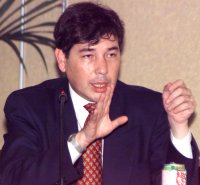 Title:
Carbon Sequestration, Biodiversity and Sustainable Livelihoods Title:
Carbon Sequestration, Biodiversity and Sustainable Livelihoods
Sponsor: The World Conservation Union (IUCN)
Contact: Brett Orlando <borlando@iucnus.org>
Internet: http://www.iucn.org
Brett
Orlando, Climate Change Program Officer, IUCN, explained that
people should be viewed as an integral part of highly complex and
diverse forest systems. He noted that many countries view forests
as a crop and fail to understand that forests provide a broader
range of services. The IUCN supports the application of an ecosystem
approach, valuing forests and other ecosystems for their full range
of services to society.
Sergio
Jaurequi, representative of Bolivia (photo above right), emphasized
that COP-5 of the Convention on Biological Diversity adopted a decision
to ensure that future carbon sequestration activities are consistent
with and supportive of the conservation and sustainable use of resources
of biological diversity. He noted that deforestation resulting from
indigenous peoples' settlement practices created a need for alternative
ways of improving the quality of life for such communities.
Speaking
for indigenous people, Hendro Sangkoyo, Consortium for Community
Forest Systems, noted that local communities and indigenous people
are largely excluded from deliberations despite living on the frontline
of climate change impacts.
|
|
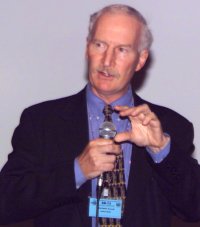 Title:
Update on the Prototype Carbon Fund, and lessons learned from
the Latvia Liepaja project Title:
Update on the Prototype Carbon Fund, and lessons learned from
the Latvia Liepaja project
Sponsor: The World Bank
Contact: Ken Newcombe <knewcombe@worldbank.org>
Internet: http://www.prototypecarbonfund.org
Ken
Newcombe, Prototype Carbon Fund (PCF) (photo right), outlined
the modalities of the fund. It aims to pool insight and experience
from the private and public sectors to mobilize additional resources
for sustainable development and address climate change concerns.
Contributing countries, of which there are currently six, will receive
a pro rata share of the emissions reductions, verified and certified
in accordance with carbon purchase agreements reached with the respective
countries hosting the projects. He emphasized that the PCF does
not invest in a project, rather it purchases the emission reductions
resulting from the project. The investment pool currently stands
at $145 million and there are 25 projects in the pipeline.
Ilze Purina, Ministry of the Environment, Latvia, outlined
her first hand experience of a project in which the PCF was involved.
Drawing on existing relations with the World Bank, Purina described
the PCF's involvement in a Landfill Gas (LFG) Project in the city
of Liepaja. Challenges included: establishing baselines; the absence
of a domestic legal framework regarding LFG; understanding the global
framework; and negotiating the carbon purchase contract. Ultimately,
the PCF's purchases of emissions reductions accounted for 4 percent
of the total budget of over $16 million.
Newcombe
noted that the greatest demand is for smaller projects and proposed
that bundling projects through intermediaries may offer a solution
to control transaction costs.
Discussion:
Exchanges focused on: private sector involvement, sustainable
development objectives, risks and benefits, methods for establishing
baselines, and the differences beetween the PCF and the operation
of the GEF.
|
|
 Title:
Potential, strategy and activities: Russian Federation United Energy
System (RAO-UES) and the implementation of the FCCC and the Kyoto
Protocol Title:
Potential, strategy and activities: Russian Federation United Energy
System (RAO-UES) and the implementation of the FCCC and the Kyoto
Protocol
Sponsor: Center for Preparation and Implementation of International
Projects on Technical Assistance (CPPI)
Contact: Marina Martynova Ph.D., CPPI <martynov@npafem.msk.ru>
Alexander
Averchenkov (CPPI), moderator, noted the Russian Federation's
potential for achieving GHG emissions reductions at low cost.
Den
Dudek, Environmental Defense, recommended that Russia pursue
its reduction of GHG emissions by developing its domestic institutions,
establishing an inventory and registry, and by creating a carbon
investment facility.
Alexander
Khanykov, representing Russia's largest energy company, United
Energy System (RAO-UES), proposed that his company's activities
in the energy sector and its GHG emission reduction potential suggested
the need to create an Energy Carbon Fund. His colleague, Mikhail
Rogankov, described the main elements of the company's action plan
for GHG emissions reduction, including its technical expertise for
the development of a company-wide GHG inventory and the creation
of a database for potential JI projects.
Marina
Martynova, CPPI (photo above right), outlined the Centre's capacity
building initiative for the energy sector. The initiative includes
priority areas such as the National Russian Strategy on GHG reduction,
the Russian Federal Order on Emissions Trading, institutional assessment,
the preparation of a Russian Carbon Fund, and business awareness
raising.
Alexander
Golub, Environmental Defense, described the organization's work
with RAO-UES to develop an emissions reduction strategy by conducting
an independent analysis. Alexey Kokorin, WWF Russian Programme Office,
noted the prioritization of energy conservation projects. Oleg Pluzhnikov,
Russian Ministry of Energy, noted that a new energy strategy would
be approved this year. He supported the creation of an inventory
and registration system for emissions trading.
Discussion:
Participants requested clarification on several technical issues,
including the possibility of imposing domestic quotas for emissions
trading.
Related
links: United Energy System of Russia: http://www.rao-ees.ru
|
| Saturday
09 September 2000 |
|
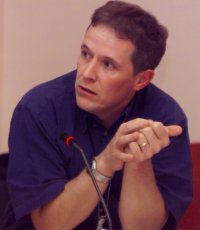 Title:
Hybrid liability revisited Title:
Hybrid liability revisited
Sponsor: Center for International Environmental Law (CIEL)
Contact: Glenn Wiser (CIEL) <glennwiser@aol.com>
Internet: www.ciel.org
Donald
Goldberg, Center for International Environmental Law (CIEL),
proposed a revised version of CIEL's hybrid liability rule for Article
17. The liability rule will address the question of whether countries
who participate in emissions trading can redeem assigned amount
units originating from Parties that exceed their targets at the
end of the commitment period. The hybrid approach is designed to
provide a point of convergence for negotiators who, for the most
part, have focused their discussions on the two extremes of pure
seller and pure buyer liability.
In sum, CIEL's revised hybrid liability rule would mean: Parties
wishing to trade must establish a commitment period reserve of assigned
amount units; the reserve is created by projecting a five-year emissions
trajectory; a Party's assigned amount, adjusted for acquisitions
and transfers of CERs, ERUs, and AAUs and emissions and removals
from LULUCF, that is surplus to the reserve may be transferred under
issuer, or seller, liability; assigned amount that is not surplus
(i.e. part of the reserve) may be transferred under user, or buyer,
liability; and the trajectory is adjusted each year to reflect the
Party's annual emissions inventory and expert review of the previous
year's inventory.
Murray
Ward, New Zealand, presented a model international emissions
trading system. The model favors transfer and acquisition activities
at the "authorized entities" level and discourages trading between
governments. He explained that trade among entities would allow
the abatement of costs across countries. Christian Albrecht,
a member of the Swiss delegation, announced his Government's intention
to introduce a revised proposal to overcome any delay in trade by
proposing the year 2008 as the date to assess emissions.
Annie
Petsonk, Environmental Defense, presented a paper on "The Dynamic
Balance Rule", which seeks to address Parties' concerns about over-selling.
The Rule shows whether at the end of the commitment period, a Party's
actual net emissions exceed its allowable emissions levels, after
the transfer of assigned amount units (AAUs).
|
|
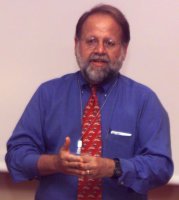 Title:
Climate change and future harvest Title:
Climate change and future harvest
Sponsor: The Consultative Group on International Agricultural
Research (CGIAR) International Center Working Group on Climate Change.
Contact: Pedro A Sanchez Ph.D. <p.sanchez@cgiar.org>
Internet: http://www.cgiar.org/icraf
Dr.
Pedro Sanchez, (photo right) International Centre for Research
on Agroforestry (ICRAF), on behalf of the CGIAR International Center
Working Group on Climate Change, presented a paper linking the Clean
Development Mechanism (CDM) with food security and poverty reduction
in the Tropics. He explained that the CGIAR centers focus on interdisciplinary
research and development on how to achieve food security and reduce
rural poverty through supporting adaptation and mitigation research
in developing countries. He identified agroforestry alternatives
to slash and burn agriculture, which achieve a dual objective of
improving farmer profitability and increasing system carbon stocks
over time. Such carbon sequestration could provide an additional
source of income for farmers through the CDM or through emerging
carbon markets. He suggested the need for pilot CDM projects with
farming communities and investors from the North and proposed that
CGIAR centres could act as honest brokers for farmers.
The panel was invited to comment on the issues. On linking poverty
reduction to the CDM, Anne-Marie Izac, ICRAF, stressed the
importance of focusing on the needs of small-scale farmers. Dr
Sheehy, International Rice Research Institute (IRRI), spoke
of the links between population growth and poverty, and the complexities
underlying food production yields. He stressed the need to maximize
crop yields while minimizing pollution, and that carbon sequestration
should be a major part of the CGIAR research agenda. Miles Fischer,
International Center for Tropical Agriculture (CIAT), spoke about
the potential for carbon sequestration in South America, and emphasized
the opportunity for a win-win scenario. In agreement, John Kadyszewski,
Winrock International, highlighted the win-win potential of carbon
credits for conversion to more carbon efficient agricultural systems.
He suggested that the CGIAR centres could provide important quality
data and capacity building for CDM activities.
Discussion:
Participants raised issues of vulnerability and risk in assuming
benefits from the CDM accruing to farmers and stressed the importance
of adaptation rather than mitigation. A US official highlighted
the importance of focusing on the sustainable development component
of the CDM, while another US official suggested researching the
potential of marrying mitigation and adaptation strategies. The
IUCN highlighted the general lack of focus on trade-offs in the
discussions on climate change.
|
|
Title:
Carbon measurements in the United States: agriculture and forestry
Sponsor: US Delegation
Contact: James Hrubovcak <jhrubovcak@oce.usda.gov>
Internet: http://www.usda.gov
This
technical presentation on carbon measurement in the United States
was introduced by Richard Birdsey, the Global Change Program.
He provided an overview of the US forest inventory, and described
methods for estimating carbon according to criteria in Articles
3.3 and 3.4 of the Kyoto Protocol. He outlined the three stages
of compiling an inventory sample: remote sensing, ground sampling
and forest health monitoring. Linda Heath addressed approaches
to the estimation of carbon change and stock changes, noting the
IPCC guidelines on uncertainty. Marlon Eve, US Department
of Agriculture, outlined approaches to enhancing carbon storage
in agricultural soils. For croplands the possibilities include:
increased crop intensity; reduced tillage; the introduction of hay
to crop rotation; fertility and water management; and the use of
high bio-mass crops. For pasture, they include using a mix of species,
and the introduction of legumes and earthworms. Panelists concluded
that cropland soils in the United States sequester approximately
16 MMT carbon per year as a result of changes in land use and management.
Grazing lands sequester about 6 MMT per year.
|
| The
Earth Negotiations Bulletin (ENB) on the side is
a special publication of the International Institute for Sustainable
Development (IISD) in cooperation with the United Nations Framework
Convention on Climate Change (UNFCCC) Secretariat. The Editor of ENB
on the side is Peter Doran Ph.D <peter@iisd.org>. This issue
has been written by Emily Boyd <E.Boyd@uea.ac.uk>, Hernan Lopez
LL.M. <hlopez@law.pace.edu> and Gerhard Mulder <gerhardmulder@hotmail.com
>. The Digital Editor is Kenneth Tong <ken@iisd.org>. Photos
by Leila Mead <leila@interport.net>. Funding for publication
of ENB on the side at SB-13 is provided by the UNFCCC Secretariat.
The opinions expressed in ENB on the side are those of the
authors and do not necessarily reflect the views of IISD and other
funders. Excerpts from ENB on the side may be used in non-commercial
publications only and only with appropriate academic citation. For
permission to use this material in commercial publications, contact
the Managing Editor at <kimo@iisd.org>. Electronic versions
of these issues of ENB on the side from SB-12 can be found
on the Linkages WWW server at http://enb.iisd.org/climate/sb13/ |
|


